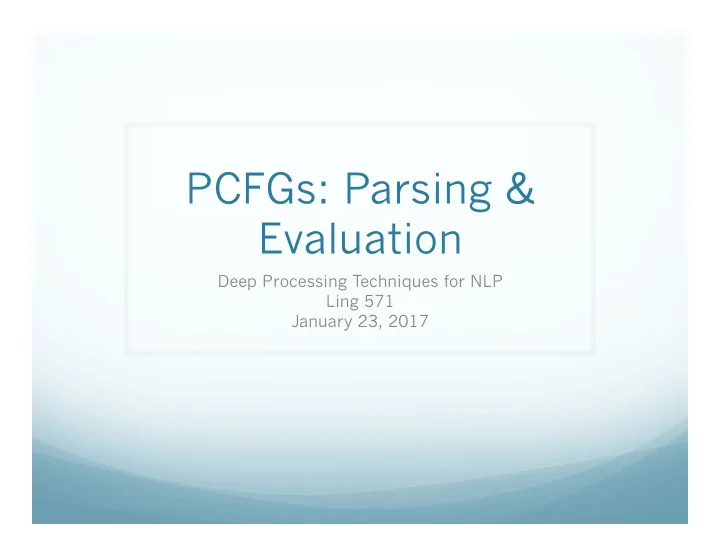

PCFGs: Parsing & Evaluation Deep Processing Techniques for NLP Ling 571 January 23, 2017
Roadmap PCFGs: Review: Definitions and Disambiguation PCKY parsing Algorithm and Example Evaluation Methods & Issues Issues with PCFGs
PCFGs Probabilistic Context-free Grammars Augmentation of CFGs
Disambiguation A PCFG assigns probability to each parse tree T for input S. Probability of T: product of all rules to derive T n ∏ P ( T , S ) = P ( RHS i | LHS i ) i = 1 P ( T , S ) = P ( T ) P ( S | T ) = P ( T )
S à NP VP [0.8] S à NP VP [0.8] NP à Pron [0.35] NP à Pron [0.35] Pron à I [0.4] Pron à I [0.4] VP à V NP PP [0.1] VP à V NP [0.2] V à prefer [0.4] V à prefer [0.4] NP à Det Nom [0.2] NP à Det Nom [0.2] Det à a [0.3] Det à a [0.3] Nom à N [0.75] Nom à Nom PP [0.05] N à flight [0.3] Nom à N [0.75] PP à P NP [1.0] N à flight [0.3] P à on [0.2] PP à P NP [1.0] NP à NNP [0.3] P à on [0.2] NNP à NWA [0.4] NP à NNP [0.3] NNP à NWA [0.4]
Parsing Problem for PCFGs Select T such that: ∧ T ( S ) = argmax Ts . t , S = yield ( T ) P ( T ) String of words S is yield of parse tree over S Select tree that maximizes probability of parse Extend existing algorithms: e.g., CKY Most modern PCFG parsers based on CKY Augmented with probabilities
Probabilistic CKY Like regular CKY Assume grammar in Chomsky Normal Form (CNF) Productions: A à B C or A à w Represent input with indices b/t words E.g., 0 Book 1 that 2 flight 3 through 4 Houston 5 For input string length n and non-terminals V Cell[i,j,A] in (n+1)x(n+1)xV matrix contains Probability that constituent A spans [i,j]
Probabilistic CKY Algorithm
PCKY Grammar Segment S à NP VP [0.80] Det à the [0.40] NP à Det N [0.30] Det à a [0.40] VP à V NP [0.20] V à includes [0.05] N à meal [0.01] N à flight [0.02]
PCKY Matrix: The flight includes a meal Det: 0.4 NP: S: 0.8* 0.3*0.4*0.02 0.000012* [0,1] =.0024 0.0024 [0,2] [0,3] [0,4] [0,5] N: 0.02 [1,2] [1,3] [1,4] [1,5] V: 0.05 VP: 0.2*0.05* [2,3] [2,4] 0.0012=0.0 00012 [2,5] Det: 0.4 NP: 0.3*0.4*0.01 [3,4] =0.0012 [3,5] N: 0.01 [4,5]
Learning Probabilities Simplest way: Treebank of parsed sentences To compute probability of a rule, count: Number of times non-terminal is expanded Number of times non-terminal is expanded by given rule Count ( α → β ) = Count ( α → β ) P ( α → β | α ) = ∑ Count ( α ) Count ( α → γ ) γ Alternative: Learn probabilities by re-estimating (Later)
Probabilistic Parser Development Paradigm Training: (Large) Set of sentences with associated parses (Treebank) E.g., Wall Street Journal section of Penn Treebank, sec 2-21 39,830 sentences Used to estimate rule probabilities Development (dev): (Small) Set of sentences with associated parses (WSJ, 22) Used to tune/verify parser; check for overfitting, etc. Test: (Small-med) Set of sentences w/parses (WSJ, 23) 2416 sentences Held out, used for final evaluation
Parser Evaluation Assume a ‘gold standard’ set of parses for test set How can we tell how good the parser is? How can we tell how good a parse is? Maximally strict: identical to ‘gold standard’ Partial credit: Constituents in output match those in reference Same start point, end point, non-terminal symbol
Parseval How can we compute parse score from constituents? Multiple measures: Labeled recall (LR): # of correct constituents in hyp. parse # of constituents in reference parse Labeled precision (LP): # of correct constituents in hyp. parse # of total constituents in hyp. parse
Parseval (cont’d) F-measure: Combines precision and recall β = ( β 2 + 1) PR F β 2 ( P + R ) 1 = 2 PR F1-measure: β =1 F ( P + R ) Crossing-brackets: # of constituents where reference parse has bracketing ((A B) C) and hyp. has (A (B C))
Precision and Recall Gold standard (S (NP (A a) ) (VP (B b) (NP (C c)) (PP (D d)))) Hypothesis (S (NP (A a)) (VP (B b) (NP (C c) (PP (D d))))) G: S(0,4) NP(0,1) VP (1,4) NP (2,3) PP(3,4) H: S(0,4) NP(0,1) VP (1,4) NP (2,4) PP(3,4) LP: 4/5 LR: 4/5 F1: 4/5
State-of-the-Art Parsing Parsers trained/tested on Wall Street Journal PTB LR: 90%+; LP: 90%+; Crossing brackets: 1% Standard implementation of Parseval: evalb
Evaluation Issues Constituents? Other grammar formalisms LFG, Dependency structure, .. Require conversion to PTB format Extrinsic evaluation How well does this match semantics, etc?
Recommend
More recommend